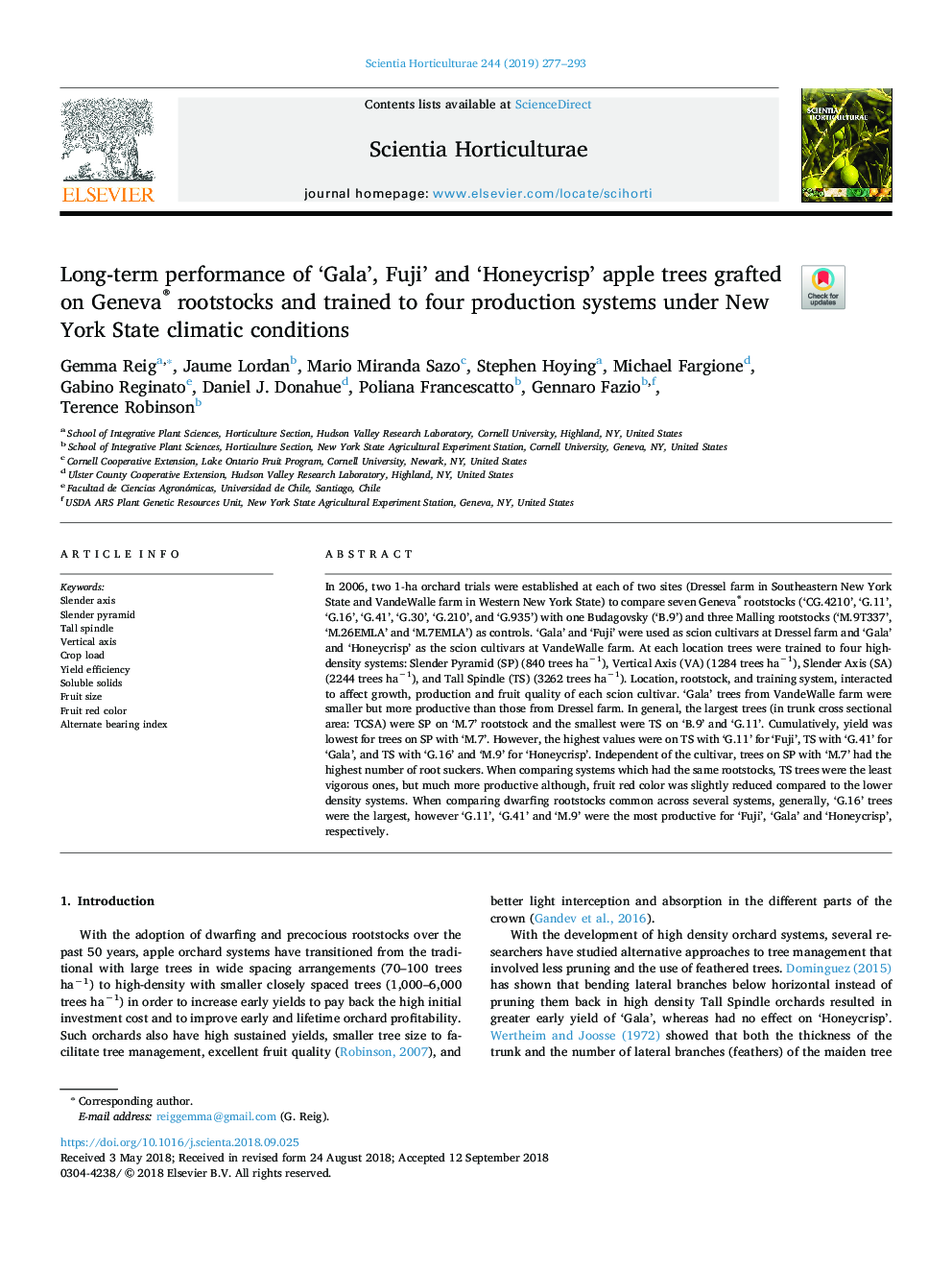| کد مقاله | کد نشریه | سال انتشار | مقاله انگلیسی | نسخه تمام متن |
|---|---|---|---|---|
| 11024821 | 1701067 | 2019 | 17 صفحه PDF | دانلود رایگان |
عنوان انگلیسی مقاله ISI
Long-term performance of 'Gala', Fuji' and 'Honeycrisp' apple trees grafted on Geneva® rootstocks and trained to four production systems under New York State climatic conditions
دانلود مقاله + سفارش ترجمه
دانلود مقاله ISI انگلیسی
رایگان برای ایرانیان
کلمات کلیدی
موضوعات مرتبط
علوم زیستی و بیوفناوری
علوم کشاورزی و بیولوژیک
دانش باغداری
پیش نمایش صفحه اول مقاله

چکیده انگلیسی
In 2006, two 1-ha orchard trials were established at each of two sites (Dressel farm in Southeastern New York State and VandeWalle farm in Western New York State) to compare seven Geneva® rootstocks ('CG.4210', 'G.11', 'G.16', 'G.41', 'G.30', 'G.210', and 'G.935') with one Budagovsky ('B.9') and three Malling rootstocks ('M.9T337', 'M.26EMLA' and 'M.7EMLA') as controls. 'Gala' and 'Fuji' were used as scion cultivars at Dressel farm and 'Gala' and 'Honeycrisp' as the scion cultivars at VandeWalle farm. At each location trees were trained to four high-density systems: Slender Pyramid (SP) (840 trees haâ1), Vertical Axis (VA) (1284 trees haâ1), Slender Axis (SA) (2244 trees haâ1), and Tall Spindle (TS) (3262 trees haâ1). Location, rootstock, and training system, interacted to affect growth, production and fruit quality of each scion cultivar. 'Gala' trees from VandeWalle farm were smaller but more productive than those from Dressel farm. In general, the largest trees (in trunk cross sectional area: TCSA) were SP on 'M.7' rootstock and the smallest were TS on 'B.9' and 'G.11'. Cumulatively, yield was lowest for trees on SP with 'M.7'. However, the highest values were on TS with 'G.11' for 'Fuji', TS with 'G.41' for 'Gala', and TS with 'G.16' and 'M.9' for 'Honeycrisp'. Independent of the cultivar, trees on SP with 'M.7' had the highest number of root suckers. When comparing systems which had the same rootstocks, TS trees were the least vigorous ones, but much more productive although, fruit red color was slightly reduced compared to the lower density systems. When comparing dwarfing rootstocks common across several systems, generally, 'G.16' trees were the largest, however 'G.11', 'G.41' and 'M.9' were the most productive for 'Fuji', 'Gala' and 'Honeycrisp', respectively.
ناشر
Database: Elsevier - ScienceDirect (ساینس دایرکت)
Journal: Scientia Horticulturae - Volume 244, 26 January 2019, Pages 277-293
Journal: Scientia Horticulturae - Volume 244, 26 January 2019, Pages 277-293
نویسندگان
Gemma Reig, Jaume Lordan, Mario Miranda Sazo, Stephen Hoying, Michael Fargione, Gabino Reginato, Daniel J. Donahue, Poliana Francescatto, Gennaro Fazio, Terence Robinson,